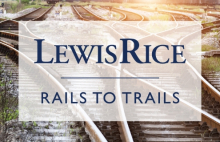Rails to Trails FAQs
What does a typical day look like for you in your practice?
My day can involve traveling across the country to meet with landowners and listening to their concerns about how the conversion of an old, abandoned railway into a public trail through their land may affect their homes, businesses or farms. On other days I may be in court either in Washington D.C. or virtually to argue motions and attend status conferences. However, many days are spent at my office in St. Louis researching and reviewing property records and law from the late 1800s or early 1900s.
What got you interested in your practice area?
I started helping on a small assignment related to a case in Kansas. From there my interest grew, and I found myself taking on more and more projects until one day, more than a decade ago, I realized it was almost exclusively what I did. I enjoy the work, and so it just came about naturally.
Part of making our cases is researching old railroad deeds. Oftentimes it involves looking at 100-year-old railroad maps, 150-year-old railroad deeds, and subdivision plans from the mid-century—and I couldn't be happier. I love doing the necessary research to prove these cases and make the case for these landowners to get paid what the Constitution allows.
Why are you passionate about this area of the law?
When I was first introduced to National Trails System Act takings cases, my first question was, “Wouldn't you rather have a trail in your backyard than a train?” But after doing these cases for more than 10 years, I can tell you that's not what these cases are about. These cases are about the fact that no one asked these landowners this question. The government simply takes property to build these trails without the landowners having any input whatsoever. My job is to rectify that.
What are some of the biggest challenges your clients face?
They may not realize that opening a portion of their land to the public can significantly impact their use and enjoyment of the property—even if the public project becomes an amenity the community likes.
How do you approach understanding your clients and their needs to provide the best legal advice?
The National Trails System Act doesn’t require the government to notify the landowners affected by these rail-trail conversions. So, they are often left wondering what their rights are and who is responsible for the damage. Many times, explaining what rights these landowners have—namely, compensation—and what rights they don’t have—getting the land back—goes a long way to help them plan for the future when it comes to the use and enjoyment of their land.
How do you stay up to date on the latest developments and trends that could impact your clients?
It is extremely important that I keep up with all rail-trail developments. Every day I review the latest decisions from the Court of Federal Claims and Surface Transportation Board and media specific to takings and condemnation.
What do you like to do outside of work?
I have two kids, and most of my time outside of work is spent with them pursuing their interests in sports and creative arts. My family loves to travel, and we’ve been fortunate enough to take our children to Europe and are planning a trip to New Zealand.
How are you involved in your community?
I stay involved with my children’s school and our religious congregation, helping with events throughout the year. I also contribute to some of my favorite charities in the area such as Marygrove and Life House Youth Center in Sullivan, Missouri.








